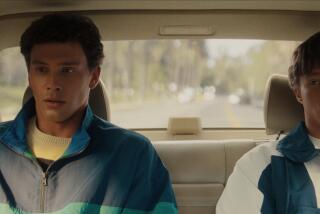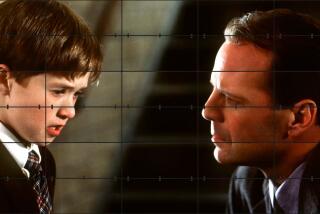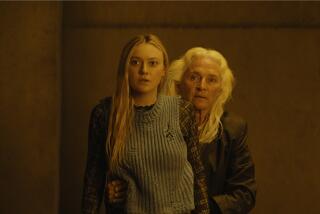M. Night Shyamalan welcomes you to scream, laugh during your ‘Visit’
M. Night Shyamalan may not call “The Visit” a horror film, but when two kids visit their grandparents’ home and strange, inexplicable things happen after dark, a little terror sets in.
“The movie is entirely about playing on all of our fears — both how we find them ridiculous and how we’re terrified by them and what happens to our minds and our bodies when we get old,” Shyamalan said.
“The Visit,” starring Kathryn Hahn, Peter McRobbie, Deanna Dunagan and young Australian actors Ed Oxenbould and Olivia DeJonge, is due in theaters Sept. 11.
HERO COMPLEX: Follow us on Twitter
The director, whose previous credits include “The Sixth Sense” and “Unbreakable,” spoke with Hero Complex about the new movie, its technical relationship with his current TV project “Wayward Pines,” and working with the film’s two young stars.
Your films feature normal people in hugely abnormal situations, but “The Visit” seems to veer into horror territory.
I’ve always felt this kind of strange reductionist thing that goes on. You know, “He makes a certain type of film.” There’s certainly more evidence than not that that’s not the case, but interestingly enough, this particular idea is a thriller. It’s primarily — 90% — a thriller, but it does tip over into extremely frightening things. I would say this is the scariest of my movies, but I’m not sure it’s a horror film.
You’ve stated that your movies have a spiritual or emotional perspective. Does that hold true for “The Visit”?
Usually, when it feels right, it dovetails with larger philosophical topics that I’m trying to talk about. These children have something in them that makes them damaged. This event, the things that happen to them on this visit, had to happen to them, otherwise they wouldn’t be able to face things like they need to. To use a movie we can talk more freely about, “Unbreakable” would be about not doing what you’re supposed to be doing. When we’re on the wrong path, everything’s difficult and out of sync. You’re not following your inner voice. The same thing is true for “The Visit.” There’s this Grimm fairy tale quality to it. There’s a very important message in it that’s important to me about where we are in each stage of our lives and how we deal with trauma.
The scene in which the grandma asks her granddaughter to get in the oven has a Grimm sense to it.
There’s definitely wild allusion to Grimm’s fairy tales there. You know how the Grimm’s fairy tales are non-categorizable? “Is this a children’s thing? This is so inappropriate!” The movie has that quality to it. My favorite thing is to watch this movie with an audience because they literally don’t know how to react to it. They feel like, “Is it appropriate to laugh here? Is it appropriate to be laughing at this?” And then they let go. They realize that it’s the actual intention of the film to make you scream and laugh almost at the same time.
Can you talk a bit about Ed Oxenbould and Olivia DeJonge, the film’s young stars?
I’ve had a lot of kids in my movies. When I saw Haley [Joel Osment] or when I saw Abigail Breslin, who was 5 years old in “Signs,” or even a slightly older Bryce Dallas Howard when I saw her in an off-Broadway play before I put her in “The Village,” they have this “I just kind of knew” vibe. That spectrum of 5-19, there’s such purity there.
As it turned out, [Ed and Olivia] were both Australian and they were both doing American accents in the audition, which is crazy! They were tough kids. I pushed them, to the point where I pulled them aside and said, “It’s not good enough.” I treat them totally as professionals. Once they get there, their ages go out the window. Until I see it go click in their eyes, we don’t roll cameras.
FULL COVERAGE: Comic-Con 2015
Speaking of cameras, you had a revelation in the physical making of the movie …
I always dreamed of doing this. There’s a technical thing called playback. Everyone does it. You record what you’re shooting and it’s in the monitor and they’ll play it back for you whenever you want. You watch it and you evaluate. For a control freak like myself, this is like cocaine.
On “Wayward Pines,” when we shot it, we didn’t have time, so we didn’t have playback. I loved it. It made me sit with the actors right there. I was more muscular. I was game-ready. You had to be razor sharp [and] listen every second and be right there. If you weren’t there, you’re just going to say do another take, but it was a waste of everybody’s time.
Dude, I was scared, but we did it on “The Visit.” What it was creating was a very electric, intimate kind of set that I loved, and for me, I know that at least until I become lazy again, I’m not doing [playback]. It creates the kind of raw performance that can only come from sitting there on your knees staring at an actor, being only five feet away from them as they’re performing.
‘Visit’ me on Twitter: @storiz
More to Read
The biggest entertainment stories
Get our big stories about Hollywood, film, television, music, arts, culture and more right in your inbox as soon as they publish.
You may occasionally receive promotional content from the Los Angeles Times.











